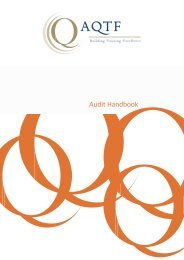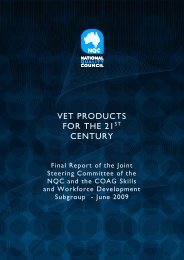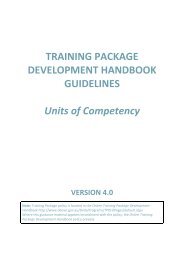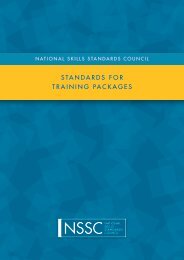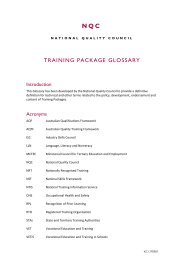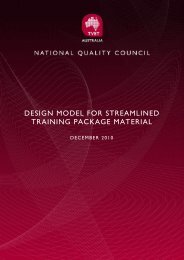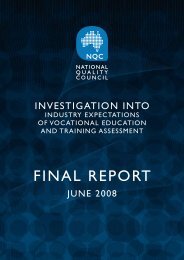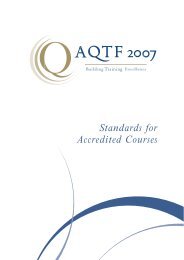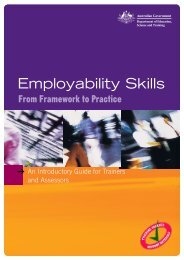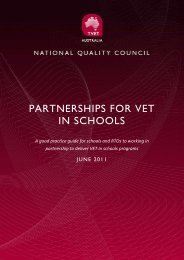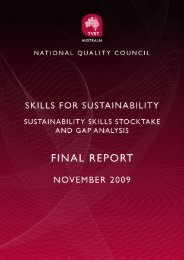Guide for Developing Assessment Tools - National Skills Standards ...
Guide for Developing Assessment Tools - National Skills Standards ...
Guide for Developing Assessment Tools - National Skills Standards ...
- No tags were found...
Create successful ePaper yourself
Turn your PDF publications into a flip-book with our unique Google optimized e-Paper software.
NQC | <strong>Guide</strong> <strong>for</strong> developing assessment toolsGlossary of TermsAccuracy of evidenceAnalytical Rubric<strong>Assessment</strong> qualitymanagement.<strong>Assessment</strong> toolAssessorAuthenticityBehaviourally Anchored RatingScales (BARS)BenchmarkComparability of standardsCompetency based<strong>Assessment</strong>Concurrent validityConsensus MeetingsConsequential validityConsistency of evidenceConstruct validityThe extent to which the evidence gathered is free from error. If error is present, theassessor needs to determine whether the amount is tolerable.An analytical rubric looks at specific aspects of the per<strong>for</strong>mance assessment. Eachcritical aspect of the per<strong>for</strong>mance is judged independently and separate judgements areobtained <strong>for</strong> each aspect in addition to an overall judgement.Processes that could be used to help achieve comparability of standards.Typically, there are three major components to quality management ofassessments: quality assurance, quality control and quality review.An assessment tool includes the following components: the context and conditions<strong>for</strong> the assessment, the tasks to be administered to the candidate, an outline of theevidence to be gathered from the candidate and the evidence criteria used tojudge the quality of per<strong>for</strong>mance (i.e. the assessment decision making rules). Italso includes the administration, recording and reporting requirements.In this <strong>Guide</strong>, an assessor means an individual or organisation responsible <strong>for</strong> theassessment of Units of Competency in accordance with the Australian Quality TrainingFramework.One of the rules of evidence. To accept evidence as authentic, an assessor must beassured that the evidence presented <strong>for</strong> assessment is the candidate’s own work.Behaviourally Anchored Rating Scales (BARS) are similar to rating scales (e.g.1=Strongly Disagree, 2=Agree, 3=Disagree and 4=Strongly Disagree) but insteadof numerical labels, each point on the rating scale has a behavioural description ofwhat that scale point means (e.g 1=the technical terms validity and reliability arestated, 2= strategies <strong>for</strong> enhancing the content validity and inter-rater reliabilityhave been built into the design of the tool, 3= evidence of how the tool has beendesigned to satisfy different <strong>for</strong>ms of validity and reliability has been provided etc).They are typically constructed by identifying examples of the types of activities orbehaviour typically per<strong>for</strong>med by individuals with varying levels of expertise. Eachbehaviour/activity is then ordered in terms of increasing proficiency and linked to apoint on a rating scale, with typically no more than five points on the scale.Benchmarks are a point of reference used to clarify standards in assessment. They areagreed good examples of particular levels of achievement which arise from themoderation process. Benchmarks help clarify the standards expected within thequalification, and illustrate how they can be demonstrated and assessed. They can alsoidentify new ways of demonstrating the competency.Comparability of standards are said to be achieved when the per<strong>for</strong>mance levelsexpected (e.g. competent/not yet competent decisions) <strong>for</strong> a unit (or cluster of units) ofcompetency are similar between assessors assessing the same unit(s) in a given RTOand between assessors assessing the same unit(s) across RTOs.Competency based assessment is a purposeful process of systematicallygathering, interpreting, recording and communicating to stakeholders, in<strong>for</strong>mationon candidate per<strong>for</strong>mance against industry competency standards and/or learningoutcomes.A <strong>for</strong>m of criterion validity which is concerned with comparability and consistency of acandidate’s assessment outcomes with other related measures of competency. Forexample, evidence of high levels of per<strong>for</strong>mance on one task should be consistent withhigh levels of per<strong>for</strong>mance on a related task. This is the transfer of learning.Typically consensus meetings involve assessors reviewing their own and theircolleagues’ assessment tools and outcomes as part of a group. It can occur withinand/or across organisations. It is typically based on agreement within a group onthe appropriateness of the assessment tools and assessor judgements <strong>for</strong> aparticular unit(s) of competency.Concerned with the social and moral implications of the value-laden assumptions that areinherent in the use of a specific task, and its interpretation in a specific, local context.The evidence gathered needs to be evaluated <strong>for</strong> its consistency with other assessmentsof the candidate’s per<strong>for</strong>mance, including the candidate’s usual per<strong>for</strong>mance levels.The extent to which certain explanatory concepts or constructs account <strong>for</strong> theGUIDE FOR DEVELOPING ASSESSMENT TOOLS PAGE 24



